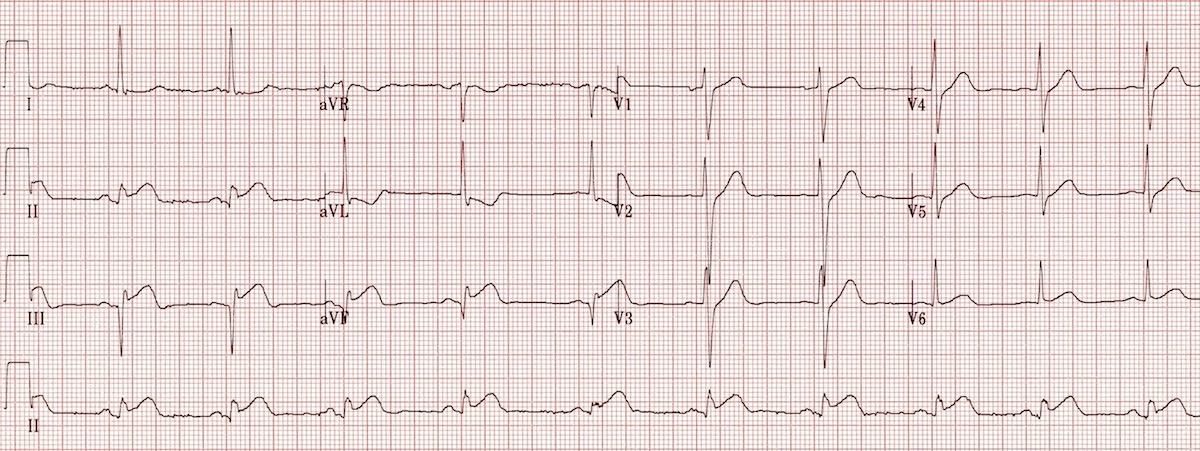[1]
Thygesen K,Alpert JS,Jaffe AS,Chaitman BR,Bax JJ,Morrow DA,White HD, Fourth universal definition of myocardial infarction (2018). European heart journal. 2018 Aug 25
[PubMed PMID: 30165617]
[2]
Pasupathy S,Air T,Dreyer RP,Tavella R,Beltrame JF, Systematic review of patients presenting with suspected myocardial infarction and nonobstructive coronary arteries. Circulation. 2015 Mar 10
[PubMed PMID: 25587100]
Level 1 (high-level) evidence
[3]
Roger VL,Weston SA,Gerber Y,Killian JM,Dunlay SM,Jaffe AS,Bell MR,Kors J,Yawn BP,Jacobsen SJ, Trends in incidence, severity, and outcome of hospitalized myocardial infarction. Circulation. 2010 Feb 23
[PubMed PMID: 20142444]
[4]
Newman JD,Shimbo D,Baggett C,Liu X,Crow R,Abraham JM,Loehr LR,Wruck LM,Folsom AR,Rosamond WD, Trends in myocardial infarction rates and case fatality by anatomical location in four United States communities, 1987 to 2008 (from the Atherosclerosis Risk in Communities Study). The American journal of cardiology. 2013 Dec 1
[PubMed PMID: 24063834]
Level 3 (low-level) evidence
[5]
Tibaut M,Mekis D,Petrovic D, Pathophysiology of Myocardial Infarction and Acute Management Strategies. Cardiovascular
[PubMed PMID: 27993119]
[6]
Arenja N,Mueller C,Ehl NF,Brinkert M,Roost K,Reichlin T,Sou SM,Hochgruber T,Osswald S,Zellweger MJ, Prevalence, extent, and independent predictors of silent myocardial infarction. The American journal of medicine. 2013 Jun
[PubMed PMID: 23597799]
[7]
Esmat S,Abdel-Halim MR,Fawzy MM,Nassef S,Esmat S,Ramzy T,El Fouly ES, Are normolipidaemic patients with xanthelasma prone to atherosclerosis? Clinical and experimental dermatology. 2015 Jun
[PubMed PMID: 25683563]
[8]
Bose A,Jain V,Kawthekar G,Chhabra C,Hemvani N,Chitnis DS, The Importance of Serial Time Point Quantitative Assessment of Cardiac Troponin I in the Diagnosis of Acute Myocardial Damage. Indian journal of critical care medicine : peer-reviewed, official publication of Indian Society of Critical Care Medicine. 2018 Sep
[PubMed PMID: 30294127]
[9]
Sabia P,Afrookteh A,Touchstone DA,Keller MW,Esquivel L,Kaul S, Value of regional wall motion abnormality in the emergency room diagnosis of acute myocardial infarction. A prospective study using two-dimensional echocardiography. Circulation. 1991 Sep
[PubMed PMID: 1884510]
[10]
Fihn SD,Gardin JM,Abrams J,Berra K,Blankenship JC,Dallas AP,Douglas PS,Foody JM,Gerber TC,Hinderliter AL,King SB 3rd,Kligfield PD,Krumholz HM,Kwong RY,Lim MJ,Linderbaum JA,Mack MJ,Munger MA,Prager RL,Sabik JF,Shaw LJ,Sikkema JD,Smith CR Jr,Smith SC Jr,Spertus JA,Williams SV, 2012 ACCF/AHA/ACP/AATS/PCNA/SCAI/STS guideline for the diagnosis and management of patients with stable ischemic heart disease: executive summary: a report of the American College of Cardiology Foundation/American Heart Association task force on practice guidelines, and the American College of Physicians, American Association for Thoracic Surgery, Preventive Cardiovascular Nurses Association, Society for Cardiovascular Angiography and Interventions, and Society of Thoracic Surgeons. Circulation. 2012 Dec 18
[PubMed PMID: 23166210]
Level 1 (high-level) evidence
[11]
Anderson JL,Karagounis LA,Califf RM, Metaanalysis of five reported studies on the relation of early coronary patency grades with mortality and outcomes after acute myocardial infarction. The American journal of cardiology. 1996 Jul 1
[PubMed PMID: 8712096]
[12]
Keeley EC,Boura JA,Grines CL, Primary angioplasty versus intravenous thrombolytic therapy for acute myocardial infarction: a quantitative review of 23 randomised trials. Lancet (London, England). 2003 Jan 4
[PubMed PMID: 12517460]
Level 1 (high-level) evidence
[13]
O'Gara PT,Kushner FG,Ascheim DD,Casey DE Jr,Chung MK,de Lemos JA,Ettinger SM,Fang JC,Fesmire FM,Franklin BA,Granger CB,Krumholz HM,Linderbaum JA,Morrow DA,Newby LK,Ornato JP,Ou N,Radford MJ,Tamis-Holland JE,Tommaso CL,Tracy CM,Woo YJ,Zhao DX,Anderson JL,Jacobs AK,Halperin JL,Albert NM,Brindis RG,Creager MA,DeMets D,Guyton RA,Hochman JS,Kovacs RJ,Kushner FG,Ohman EM,Stevenson WG,Yancy CW, 2013 ACCF/AHA guideline for the management of ST-elevation myocardial infarction: a report of the American College of Cardiology Foundation/American Heart Association Task Force on Practice Guidelines. Circulation. 2013 Jan 29
[PubMed PMID: 23247304]
Level 3 (low-level) evidence
[14]
O'Gara PT,Kushner FG,Ascheim DD,Casey DE Jr,Chung MK,de Lemos JA,Ettinger SM,Fang JC,Fesmire FM,Franklin BA,Granger CB,Krumholz HM,Linderbaum JA,Morrow DA,Newby LK,Ornato JP,Ou N,Radford MJ,Tamis-Holland JE,Tommaso JE,Tracy CM,Woo YJ,Zhao DX, 2013 ACCF/AHA guideline for the management of ST-elevation myocardial infarction: executive summary: a report of the American College of Cardiology Foundation/American Heart Association Task Force on Practice Guidelines. Circulation. 2013 Jan 29
[PubMed PMID: 23247303]
Level 3 (low-level) evidence
[15]
Shetabi K,Ullah R,Patel R,Wilson T,Siddiqua T,Olet S,Ammar KA,Jahangir A,Allaqaband SQ,Bajwa T,Jan MF, Contemporary practice pattern of revascularization in a large tertiary care referral center in non-ST elevation myocardial infarction: A propensity-matched 10-year experience. Catheterization and cardiovascular interventions : official journal of the Society for Cardiac Angiography
[PubMed PMID: 30265421]
[16]
Amsterdam EA,Wenger NK,Brindis RG,Casey DE Jr,Ganiats TG,Holmes DR Jr,Jaffe AS,Jneid H,Kelly RF,Kontos MC,Levine GN,Liebson PR,Mukherjee D,Peterson ED,Sabatine MS,Smalling RW,Zieman SJ, 2014 AHA/ACC guideline for the management of patients with non-ST-elevation acute coronary syndromes: executive summary: a report of the American College of Cardiology/American Heart Association Task Force on Practice Guidelines. Circulation. 2014 Dec 23
[PubMed PMID: 25249586]
Level 3 (low-level) evidence
[17]
McManus DD,Gore J,Yarzebski J,Spencer F,Lessard D,Goldberg RJ, Recent trends in the incidence, treatment, and outcomes of patients with STEMI and NSTEMI. The American journal of medicine. 2011 Jan
[PubMed PMID: 21187184]
[18]
Hreybe H,Saba S, Location of acute myocardial infarction and associated arrhythmias and outcome. Clinical cardiology. 2009 May
[PubMed PMID: 19452487]
[19]
Morrow DA,Antman EM,Parsons L,de Lemos JA,Cannon CP,Giugliano RP,McCabe CH,Barron HV,Braunwald E, Application of the TIMI risk score for ST-elevation MI in the National Registry of Myocardial Infarction 3. JAMA. 2001 Sep 19
[PubMed PMID: 11560541]
[20]
Wing RR, Lang W, Wadden TA, Safford M, Knowler WC, Bertoni AG, Hill JO, Brancati FL, Peters A, Wagenknecht L, Look AHEAD Research Group. Benefits of modest weight loss in improving cardiovascular risk factors in overweight and obese individuals with type 2 diabetes. Diabetes care. 2011 Jul:34(7):1481-6. doi: 10.2337/dc10-2415. Epub 2011 May 18
[PubMed PMID: 21593294]
[21]
Choi YJ,Park JS,Kim U,Lee SH,Son JW,Shin DG,Kim YJ,Jeong MH,Ahn YK,Cho MC,Bae JW,Kim CJ,Cho JM,Han KR,Lee JH, Changes in smoking behavior and adherence to preventive guidelines among smokers after a heart attack. Journal of geriatric cardiology : JGC. 2013 Jun
[PubMed PMID: 23888174]
[22]
Coons JC,Fera T, Multidisciplinary team for enhancing care for patients with acute myocardial infarction or heart failure. American journal of health-system pharmacy : AJHP : official journal of the American Society of Health-System Pharmacists. 2007 Jun
[PubMed PMID: 17563049]
[23]
Fanari Z,Barekatain A,Kerzner R,Hammami S,Weintraub WS,Maheshwari V, Impact of a Multidisciplinary Team Approach Including an Intensivist on the Outcomes of Critically Ill Patients in the Cardiac Care Unit. Mayo Clinic proceedings. 2016 Dec
[PubMed PMID: 28126152]



